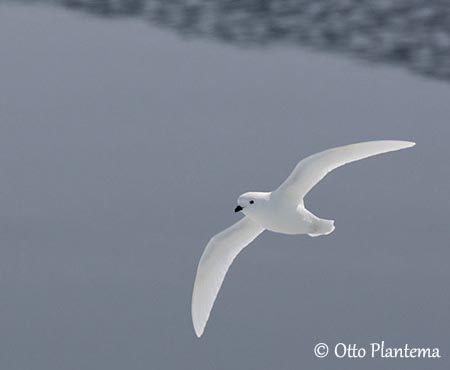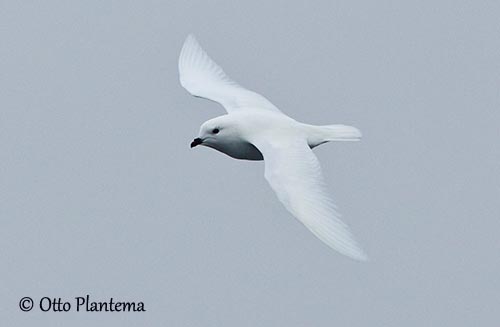
Fr: Pétrel des neiges
Ang: Snow Petrel
All: Schneesturmvogel
Esp: Petrel Níveo
Ita: Petrello delle nevi
Nd: Sneeuwstormvogel:
Sd: Ispetrell
Photographer:
Otto Plantema
Trips around the world
Text by Nicole Bouglouan
Sources:
HANDBOOK OF THE BIRDS OF THE WORLD vol 1 by Josep del Hoyo-Andrew Elliot-Jordi Sargatal - Lynx Edicions - ISBN: 8487334105
A Complete Guide to Antarctic Wildlife by Hadoram Shirihai and Illustrated by Brett Jarrett - Edited by Guy M. Kirwan - ALUL.A Press Oy, Finland - ISBN 9519894705
BirdLife International (BirdLife International)
Australian Antarctic Division: Leading Australia's Antarctic Program
New Zealand birds and birding (Narena Olliver)
Snow Petrel
Pagodroma nivea
Procellariiformes Order – Procallariidae Family
INTRODUCTION:
The Snow Petrel is distinct enough to be placed in the monotypic genus Pagodroma. It has two subspecies of very different sizes but they have similar plumages.
It frequents the pack ice where its pure white plumage blends into both snow and ice. This is a species of the Antarctic, taking advantage of food abundance beneath the ice even in bad weather conditions, involving the rarity of foraging competitors.
The Snow Petrel is one of the most beautiful of the Antarctic seabirds.

DESCRIPTION OF THE BIRD:
Biometrics for both subspecies:
Length: 30-40 cm
Wingspan: 75-95 cm
Weight: 200-460 g
The Snow Petrel is the only petrel species with pure white plumage overall. The black bare parts contrast strongly, including the short, slender, blue-black bill, the dark brown eyes, and the blue-black legs and webbed feet.
The tail is wedge-shaped and the wings are fairly long.
Both adults are similar, but the female is usually slightly smaller overall.
The juvenile shows black barring on the upperparts.
SUBSPECIES AND RANGE:
The Snow Petrel has two recognized subspecies.
P.n. nivea or Lesser Snow Petrel (here displayed) is found in Antarctic Southern Ocean. It breeds in Antarctica, Scotia Arc and South Georgia.
P.n. major or Greater Snow Petrel occurs in Antarctica and adjacent islands, and South Sandwich Island. This one has heavier bill and is much larger than previous.
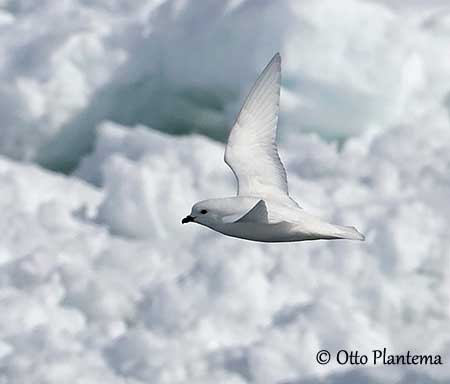
HABITAT:
The Snow Petrel is a marine species closely associated to the pack ice. It can be seen from the edge of the pack ice to the continental ice-shelf. They form flocks in open water with icebergs and frequently roost on them. They feed in tide cracks where preys are abundant.
It nests in exposed rocky cliffs, but several breeding sites are far into the interior of the continent. The nest is placed in rock crevice or small caves, under overhanging rocks, face the prevailing wind, up to 2400 metres of elevation.
CALLS AND SONGS: SOUNDS BY XENO-CANTO
The Snow Petrel is usually silent at sea, but when they are foraging in flocks, they give twittering calls. The adults cluck and screech. We can also hear harsh, guttural sounds given from the ground “kaa-kaa-kaa-kaa” and high-pitched “kir-kir-kir”.
During the aerial displays, male and female utter churring calls above the nest-site and plaintive calls while mating.
The larger birds have lower-pitched voice, and the male’s voice is typically lower than that of female.
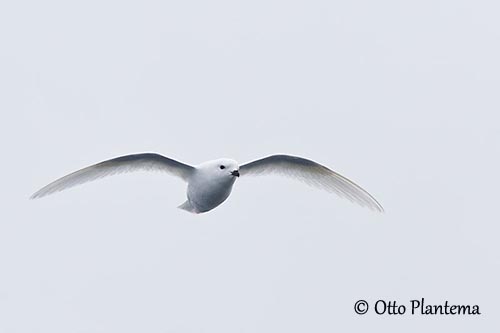
BEHAVIOUR IN THE WILD:
The Snow Petrel feeds primarily on fish, squid, molluscs, crustaceans, and mainly krill of genus Euphausia. But it also feeds on seal placenta and carcasses, dead seabirds and penguins, and it may take refuse on land.
It catches its preys by aerial and contact dipping, surface-diving and surface-seizing. It also uses pattering and pursuit-diving with open wings. The bird often pecks continuously the surface white moving the wings to maintain the balance, and rotating its body with the feet touching the water. It may feed in association with whales and other petrels.
The Snow Petrel is usually loosely gregarious at sea and at breeding sites. They are not truly colonial and the nests are sparsely scattered, often among large concentrations with other petrel species on limited ice-free space.
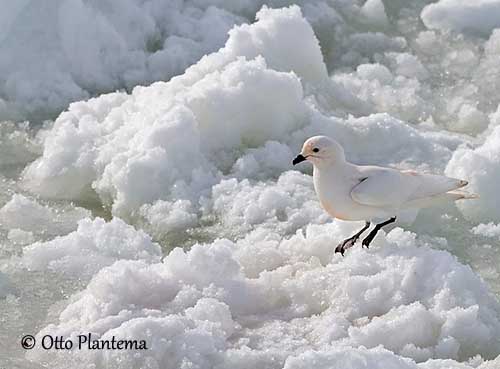
Prior to the breeding season, male and female perform aerial displays. The female flies around the nesting area and the male follows her. Then, both birds fly around the cliffs at high speed, rising and diving alternately almost into the cliff face before changing the direction abruptly with a twist of the wing.
The male tries to remain as close as possible to the female, but numerous males seem to be left behind, at least during the first days of these displays. This high speed aerial ballet is an amazing sequence.
Other displays include head-raising, bill-fencing, bill-kissing and mutual preening.
Some threat displays are used against intruders. The nesting bird squirts foul-smelling orange stomach oil at other petrels, skuas or humans through the open mouth. The stained birds need to clean their feathers in the snow, as this stomach oil is difficult to remove. They may fight too, using bill and wings.
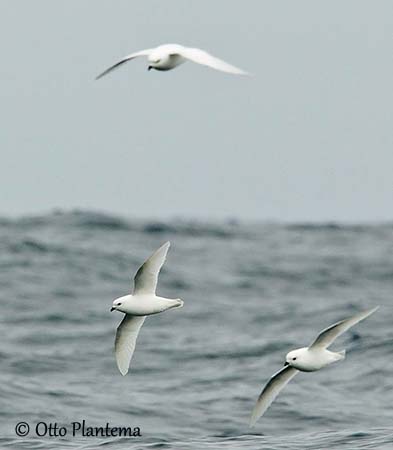
The Snow Petrel ranges N at sea outside the breeding season. It is vagrant to Heard, Macquarie and Kerguelen Islands, and may occur in Argentine waters in SW Atlantic.
However, most of them remain year-round in the vicinity of their breeding areas and only disperse to adjacent waters.
The Snow Petrel is an agile flier and usually flies low over water with rapid wingbeats and some glides, but less than other petrels.
REPRODUCTION OF THIS SPECIES:
The breeding season starts in late October/early November, with the egg-laying in November/December. Males and females perform a pre-laying exodus of 12-20 days for feeding.
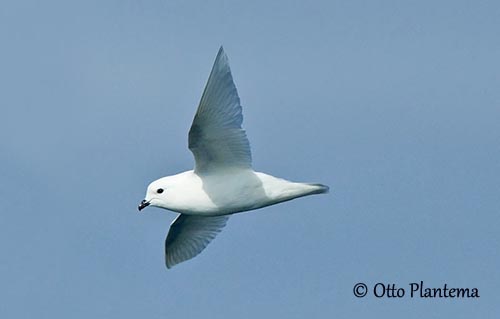
The Snow Petrel forms loosely spaced colonies, sometimes with Daption capensis. It breeds on glaciated islands and continental Antarctica, with colonies up to 440 km inland in the Theron Mountains.
The nest is a shallow scrape lined with pebbles, placed in rock crevice, small cave, or on snow-free rocky ledge with overhanging protection.
The female lays a single white egg. Both adults share the incubation during 41-49 days. At hatching (in January), the chick has pale ash-grey down above and paler below. Both parents brood it during the first week. It is fed on krill and fish. It fledges between 42 and 54 days after hatching.
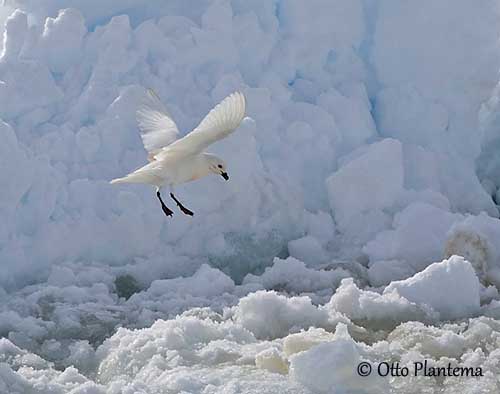
PROTECTION / THREATS / STATUS:
The Snow Petrel is one of the most abundant seabirds of the Antarctica. It may be threatened in the future by climate change involving the reduction of the sea-ice cover and the decrease of preys in some areas. In the same way, the increasing length on the sea-ice season may involve more difficult access to the breeding sites.
The population is estimated to exceed 4,000,000 individuals and is suspected to be stable.
The Snow Petrel is currently evaluated as Least Concern.
